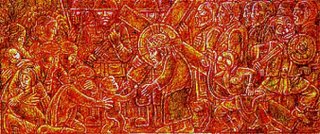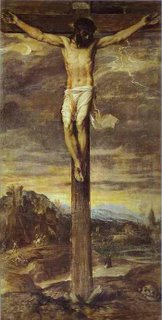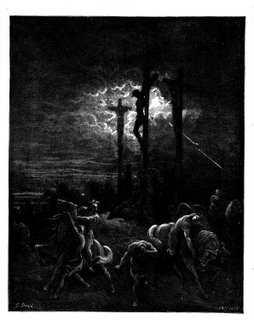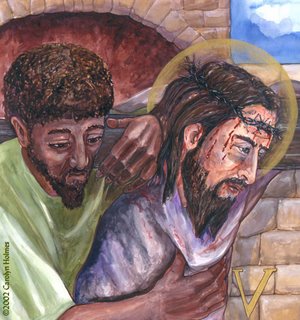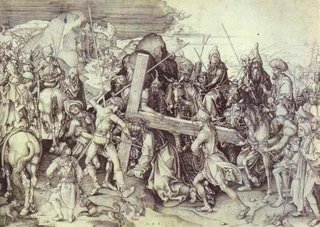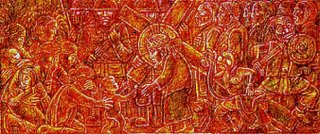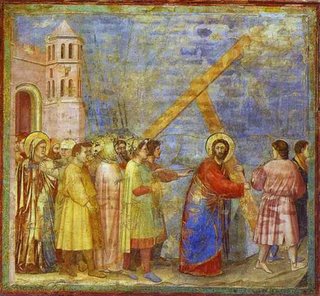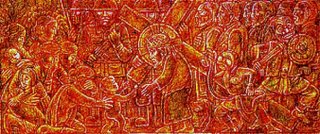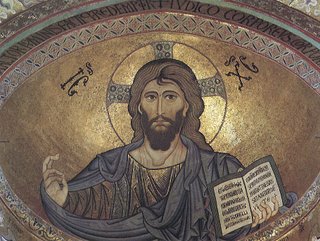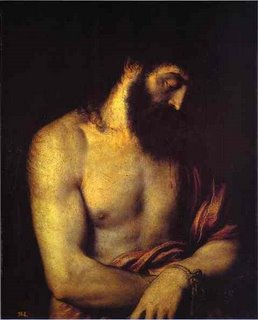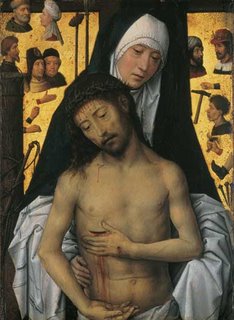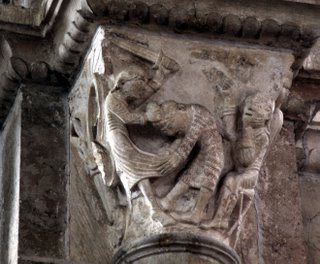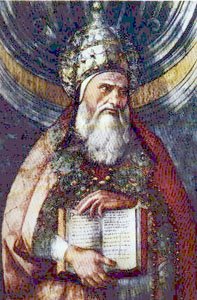
Pius I, pope 142-155.
A friend of mine emailed me the following diatribe. Apparently it was from a website making fun of the more extreme Catholic traditionalists. The site no longer exists, so I decided to reproduce it here. It's very funny. They get the tone and the reasoning down, from the USE OF CAPITALS to the accusations of Freemasonry. It also cleverly points out the dangers of obsessively reductive traditionalism.
Before the fun starts, I want to state that I have no bone to pick with less extreme traditionalists as long as they have no bone to pick with me. I think the Latin liturgy is beautiful and have no problem with the Latin Mass being available as long as it is not the only alternative. I myself prefer a Mass that is lively and partcipatory but also solemn and aware of tradition. Some Latin is always nice. For more discussions on liturgy, I recommend the blog
Catholic Sensibility, which features thoughtful posts on the liturgy and varied but respectful comments from those who agree and disagree with the posts.
Here's the fun:
The Society of St. Pius I
"To be any more Trad, you'd have to be Jewish"
Welcome to the fledgling website of the Society of St. Pius I (SSPI). Unlike other so-called "traditionalist" Roman Catholic groups, we adhere to the ORIGINAL Roman Catholic Mass of A.D. 40-200, and described by St. Justin Martyr and the Apostolic Constitutions, and used by Pope St. Pius I of happy memory.
Don't be fooled by PHONY "Vulgate" neotraditionalists, who claim to protect tradition, and yet still defend the RADICAL and totally UNCATHOLIC reforms of the 4th century A.D. So-called "trads" pretend to be against the modernism of the last hundred years, but where were they when the original Rite of Rome, the Greek rite USED BY ST. PETER AND THE APOSTLES was being totally gutted and revised by unknown scholars and translated into the vernacular language of Latin?
Unlike other wimpy neotraditionalist groups who attach themselves to various other Piuses, we at the SSPI make absolutely ZERO compromises with modernism. We reject not just one, but BOTH "Novus Ordos"-the Novus Ordo of 1970 promulgated by Paul VI, and the Latin Vulgate Mass of 400 A.D. promulgated by Innocent I and Pope Gregory I, which we call the "Vulgar Mass."
Thanks to the miracle of the internet, we can now spread the TRUTH about the REAL Roman liturgical tradition which is being kept alive only by a brave remnant of faithful Catholics: myself and whoever else wants to join.
--Klaudios Philadelphou, Archon and Caesaropapist of the SSPI
"We're not approved...and we don't want to be"
Facts everyone NEEDS to know about the "Traditional" Latin Mass
FACT: Even the neotrad "Catholic Encyclopedia" admits the Latin Mass was a radical break with tradition! The REAL Traditional Roman Mass is the Greek Mass of the first three centuries as described by the Apostolic Constitutions and the Apology of St. Justin Martyr. The "Catholic Encyclopedia" written and published in 1913 by diehard "pre-Vatican II" neotrads, was forced to admit that its oh-so-precious "Latin Mass" was a radical and unprecedented break from tradition unlike any that had ever gone before.
Just read these shocking quotes from the article "Liturgy of the Mass":
"The origin of the Roman Mass, on the other hand, is a most difficult question. We have here two fixed and certain data: the Liturgy in Greek described by St. Justin Martyr (d. c. 165), which is that of the Church of Rome in the second century, and, at the other end of the development, the Liturgy of the first Roman Sacramentaries in Latin, in about the sixth century. The two are very different."
"He [Justin Martyr] describes how the Holy Eucharist was celebrated in Rome in the middle of the second century...we have hardly any knowledge at all of what developments the Roman Rite went through during the third and fourth centuries...By the fifth century, we come back to comparatively firm ground, after a radical change."
"But between this original Roman Rite (which we can study only in the Apost. Const.) and the Mass as it emerges in the first sacramentaries (sixth to seventh century) there is a great change."
"This brings us back to a most difficult question: Why and when was the Roman Liturgy changed from what we see in Justin Martyr to that of Gregory I? The change is radical, especially as regards the most important element of the Mass, the Canon."
"At Rome the Eucharistic prayer was fundamentally changed and recast at some uncertain period between the fourth and the sixth and seventh centuries. During the same time the prayers of the faithful before Offertory disappeared, the kiss of peace was transferred to after the Consecration, and the Epiklesis was omitted or mutilated into our ‘Supplices’ prayer.”
Finally, the article quotes the liturgical historian Rauschen as saying:
"We must then admit that between the years 400 and 500 a great transformation was made in the Roman Canon."
What more proof could anyone POSSIBLY need?! The so-called “Traditional Latin Mass" is NOT traditional at all!!! It's a drastic change in 200 years of liturgical tradition, and one concocted by unknown scholars and unaccountable liturgical "experts." It is a dangerous modern innovation that is putting millions of souls in jeopardy!!
FACT: Latin is NOT the original language of the Church!
It's a VERNACULAR language that was foisted on the Roman church by Pope Victor I (A.D. 190-202), who was an AFRICAN priest--NOT a Roman!!! The earliest liturgies at Rome as described by St. Justin Martyr were in GREEK. But once Victor made the change in language, that OPENED THE DOOR a century later to a barrage of changes in the rite of Mass itself, from which the Roman Rite has NEVER recovered.
This opening up of vernacular languages has led to the Church becoming a veritable Tower of Babel, full of all sorts of barbarian languages that were NOT SPOKEN BY THE APOSTLES. Was this what Christ intended when he prayed that the church be one? A hodgepodge of incomprehensible barbarian tongues that were formerly used to worship fake gods like Jupiter?
Die-hard Vulgate Pope John VIII even allowed Cyril and Methodius to translate the liturgy for the Slavs into Old Church Slavonic!!
Wouldn't you want to use a language that was actually spoken by the Apostles, rather than some barbarian language spoken by goatskin wearing savages? EVERY SINGLE BOOK of the New Testament was written in GREEK. Not Latin. Not Syriac. Not Coptic. Not Old Church Slavonic. And especially not English. This fact alone PROVES that these other languages are inventions of SATAN and CONDEMNED BY GOD.
So whatever later so-called "Popes" may have said about the use of Latin, it IS NOT TRADITIONAL!!!
And even further, linguists have shown that Nero--who is identified by some biblical scholars as the archetype of Antichrist in Revelation--spoke Latin. Do you really think God would want you to be using the Antichrist's language--IN A CHURCH?????
FACT: The traditional Roman Mass was celebrated in catacombs, NOT churches!!!
Above ground churches are a LATE development in the Roman church which date to the legalization of Christianity by Constantine. They were NEVER part of the original Roman rite!
So what was so wrong with the church going above ground? Above ground is where PAGAN temples were built. And in order to appease and "get along with" their new false-god worshiping neighbors, modernist Romans started to build unholy ecumenical shrines that confirmed and incorporated their wrong and idolatrous ideas. Don't just take my word for it--just ask a Jehovah's Witness--even they'll tell you it's true!!!
The Pantheon for instance, was a PAGAN Roman temple which was reconsecrated as a church by Pope Boniface in A.D. 609!! Pagan building, Catholic building--what's the difference, right?? Then in the reign of Pope Zacharias (741-752) another church was built on the ruins of a pagan temple and called "Santa Maria sopra Minerva". Minerva was a Roman goddess—many Catholics DIED HORRIBLE DEATHS rather than offer a tiny pinch of incense to her. And yet their supposedly Christian descendants NAMED a church after her!!! Even the ecumaniacs at Assisi never did anything like this--put a false goddess' name ON PAR with the Virgin Mary, Mother of God!!!!
In accord with holy tradition therefore, we must reject any and all above-ground church structures, in accordance with the true traditional practice of the Roman church. Unfortunately, funding issues and zoning laws in our locality have so far prevented us from excavating new catacombs in our area, so we are temporarily headquartered behind the water heater in our basement.
FACT: Pope Gregory the "Great" was a liturgical "reformer"
Neotrads love to say their Mass goes back to Pope Gregory I in the 6th century. But how much do they REALLY know about this ultraliberal legislator who helped solidify the final destruction of the TRUE traditional Roman Rite?
Even a pope firmly entrenched in the Vulgar Mass, Benedict XIV said that "no pope has added to, or changed the Canon since St. Gregory." He thus ADMITS that St. Gregory changed the Canon!!!
Gregory's biographer John the Deacon tells us that Gregory "collected the Sacramentary of Gelasius in one book, leaving out much, changing little, adding something for the exposition of the Gospels."
Gregory also moved the Our Father from the end of the Mass to the Canon. He also added the phrase "Diesque nostros" to the Hanc Igitur prayer. This is the prayer that says "Graciously accept, then, we beseech You, O Lord, this service of our worship and that of all Your household"--it asks God to accept ALL forms of worship!!! Incredibly, Gregory did NOT change this part of the prayer despite its obviously heretical approval of false worship!!!
To make matters worse, in a letter published in Bede's Ecclesiastical History of the English Nation, Pope Gregory approved a totally untraditional ecumenical "concoction" for use in Britain: "Your brotherhood knoweth the custom of the Church of Rome...But it pleaseth me, if you have found anything, be it in the Church of Rome, or France or any other...zealously choose and spread in the Church of the English...the things that you have been able to gather from many Churches." So instead of demanding that Augustine use the traditional Greek Mass to England, Gregory just had him cobble together an "ecumenical" liturgy from every country and "zealously" spread it. Neotrads complain to no end about Cranmer's Protestant Mass in England, but Gregory started the trend a thousand years before!!! Cranmer just finished the job!!
We also have a reliable source from Italy who informs us that a recently excavated mosaic clearly depicts Pope Gregory kissing Vergil's Aeneid!!!
But to answer the question on everyone's mind, was Pope Gregory a Freemason?
Despite apparently accurate claims that the organization did not even exist back then, the Freemasons THEMSELVES claim otherwise, and say that they date back to Ancient Egypt. It is therefore POSSIBLE that a fifth century pope may have joined the organization. Significantly, our top researchers at the Society have NOT been able to DISPROVE Gregory's membership in the Masons, and, most importantly, NEITHER HAS ANYONE ELSE. Prudence therefore DEMANDS that we treat all of his liturgical "reforms" as HIGHLY suspect and potentially heretical.
Pope Gregory was the "Great" all right--the great changer of the Canon and the great ecumaniac to boot!!
Fact: the people behind the "Latin Mass" promoted Dialogue with FALSE RELIGIONS!!!
Neotrad "Saint" Jerome, who imposed his Vulgate Bible on the Latin world, took instruction in Hebrew and Talmud from Jewish scholars, and even followed their opinions (e.g. in his Commentary on Joel iv. 11). Says the Jewish Encyclopedia: "Although other Church Fathers quote Jewish traditions none equal Jerome in the number and faithfulness of their quotations". He was being "faithful" to Judaism's traditions, while at the same time ruining Catholic traditions by translating the Bible into the evil language of Nero!
Most shockingly of all, Jerome also wrote a book called "Dialogue with the Luciferians" --LUCIFER????? Is there NO ONE these neotrads won't DIALOGUE with????!!!! At what point do we just say--NO... WE DON'T DIALOGUE WITH LUCIFERIANS??!!!
By the way, some snide sarcastic modernist type pointed out that our hero St. Justin Martyr also wrote a "Dialogue with Trypho the Jew." Yeah, we knew that. So what?
FACT: St. Paul said to "hold fast to the traditions you have been taught"
Ask yourself--are today's Novus Ordo neocons and Latin Mass neotrads REALLY holding fast to TRUE ROMAN tradition?
DID they hold fast to the Greek liturgy that St. Peter and Paul brought to Rome? Or are they just too happily clueless in their little Gallicanized-Roman Rite and its "ecumenical" combination of Latin and Frankish??
ANNOUNCEMENT: Real Traditionalist Priests wanted!!
No priest has of yet had the courage to join our brave and heroic movement. So we are currently looking for Greek-speaking priests who may have said the liturgy of St. Justin Martyr in their youth. Candidates must be able to prove Apostolic Succession directly from Popes Peter, Linus, Cletus or Clement.
NOTE: Greek Catholic/ Greek Orthodox Rite priests NEED NOT APPLY!!!
We have arbitrarily decided not to like you guys either.
 I have instructed Yahoo to send me an email whenever it comes across an article that contains the words "medieval" [because that's what I study], "professor," [because that usually means there is an academic voice commenting on whatever the issue at hand is], and "king," [because I study kinship]. More often than not, the stories they send me are extremely arbitrary, but sometimes I find something fun, and on rare occasions, I find something useful.
I have instructed Yahoo to send me an email whenever it comes across an article that contains the words "medieval" [because that's what I study], "professor," [because that usually means there is an academic voice commenting on whatever the issue at hand is], and "king," [because I study kinship]. More often than not, the stories they send me are extremely arbitrary, but sometimes I find something fun, and on rare occasions, I find something useful.







